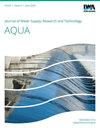电混凝-在线-电解联合消毒工艺去除水中的氟化物和病原体
IF 4.3
Q2 Environmental Science
引用次数: 0
摘要
本文报道了铝和尺寸稳定的混合氧化物电极采用电凝-在线-电解联合消毒(EC-ECl2)工艺对饮用水中氟(除氟)和病原体(消毒)的连续去除。对流量、初始pH值、电流密度和辅助电解质对除氟和消毒过程的影响进行了实验室试验。结果表明,在流速为10 L/h、初始pH为6、电流密度为9.4 mA/cm2 (EC电池)和3.1 mA/cm2 (ECl2电池)、支撑电解质浓度为165 mg/L、电解时间为50 min的条件下,除氟率可达88%(初始浓度为12.3 mg/L),完全消毒(初始粪便大肠菌群为每100 mL (CFU/100 mL) 19,700个菌落形成单位)。处理后的水中氟化物和病原体的最终浓度分别为1.44毫克/升和0 CFU/100毫升,均在世界卫生组织和坦桑尼亚标准局分别为1.5毫克/升和0 CFU/100毫升的可接受限度之内。EC-ECl2系统是一种有前途的连续除氟和消毒水的方法,可使数百万人免于氟中毒和水传播疾病。然而,确定了能量效率和系统复杂性方面的优化潜力。本文章由计算机程序翻译,如有差异,请以英文原文为准。
Removal of fluoride and pathogens from water using the combined electrocoagulation-inline-electrolytic disinfection process
The consecutive removal of fluoride (defluoridation) and pathogens (disinfection) in drinking water through combined electrocoagulation-inline-electrolytic disinfection (EC–ECl2) process with aluminum and dimension-stable mixed oxide electrodes was reported in this study. Laboratory trials were conducted on the effects of flow rate, initial pH, current density, and supporting electrolytes for defluoridation and disinfection processes. The results have shown that with a flow rate of 10 L/h, initial pH of 6, the current density of 9.4 mA/cm2 (EC cell) and 3.1 mA/cm2 (ECl2 cell), supporting electrolyte concentration of 165 mg/L, and electrolysis time of 50 min, a defluoridation rate of 88% (initial concentration of 12.3 mg/L) and complete disinfection (initial fecal coliforms of 19,700 colony-forming units per 100 mL (CFU/100 mL)) can be reached. The final concentration of fluoride and pathogens in treated water was 1.44 mg/L and 0 CFU/100 mL, which are within the acceptable limit of the World Health Organization and the Tanzania Bureau of Standards of 1.5 mg/L and 0 CFU/100 mL, respectively. The EC–ECl2 system is a promising approach for consecutive defluoridation and disinfection of water to save millions from fluorosis and waterborne diseases. However, optimization potential with regard to energetic efficiency and system complexity was identified.
求助全文
通过发布文献求助,成功后即可免费获取论文全文。
去求助
来源期刊
CiteScore
4.70
自引率
0.00%
发文量
74
审稿时长
4.5 months
期刊介绍:
Journal of Water Supply: Research and Technology - Aqua publishes peer-reviewed scientific & technical, review, and practical/ operational papers dealing with research and development in water supply technology and management, including economics, training and public relations on a national and international level.

 求助内容:
求助内容: 应助结果提醒方式:
应助结果提醒方式:


